Kenneth Armitage 1916-2002
64.8 x 40.7 x 27 cm
People in the Wind (1959) is, along with Armitage's Family Going for a Walk (1951), one of his two best-known and most popular sculptures in which we see both humour and movement. An earlier version of the present work was included in the landmark exhibition of eight young sculptors at the 1952 Venice Biennale, which provided a prominent platform for Armitage's work and was also the occasion for Herbert Read's famous phrase 'the geometry of fear'. Armitage confirmed the consequences of showing People in the Wind at the Biennale as a hugely significant moment in his career when he stated that 'before showing this piece at the 1952 Biennale I was unknown. After it, I had an international name.'
The present work attests to the ways in which Armitage explored the theme of interlinked figure groups, and was a motif echoed from his earlier work. The sculptor Anthony Gormley (b.1950) commented that it expresses 'an intuitive understanding of posture that is not to do with action but with reaction, or the way the body accommodates its environment – in this case, leaning into the wind. There is no mass in this sculpture; it is as if the bodies are given their weight by the invisible wind'.
The inspiration for People in the Wind centred on a specific memory from his home in London and a view that lay outside his studio of plants forming by his door, both of which resulted in the angularity and playfulness in the figures’ posture we see in the present work. Armitage wrote of this inspiration in ways that make familiar the whimsy of the human form when he described how the piece had ‘a pronounced front and side elevation with two membranes meeting at right angles giving the idea of bulk without solid convex forms. The elongated and slightly divergent necks derived from the plants which grew at my studio door and which I watched and drew because of their structural buoyancy. Each had half a dozen stalks coming up and a small stem absolutely upright and straight and opening out of the top. This gave an intended lightness and economy, away from the heavy masses which I associate with my previous stone carving. The subject of people struggling against the wind came from seeing, from the window in my London flat, a mother and her two children struggling against a strong wind. If you look at a crowd, you do not count the arms and legs, you just see odd arms swinging and the odd leg moving’.
Provenance
Galerie Schmela, DüsseldorfLiterature
Norbert Lynton (intro.), Kenneth Armitage, An Arts Council Exhibition, Lund Humphries, London, 1973, illustrated n.p. (another cast);Tamsyn Woollcombe (ed.), Kenneth Armitage: Life and Work, The Henry Moore Foundation in association with Lund Humphries, London, 1997, no. KA8, illustrated p. 28 (another cast);
James Scott and Claudia Milburn, The Sculpture of Kenneth Armitage, Lund Humphries, London, 2016, no. 14, illustrated p. 93 (another cast)




